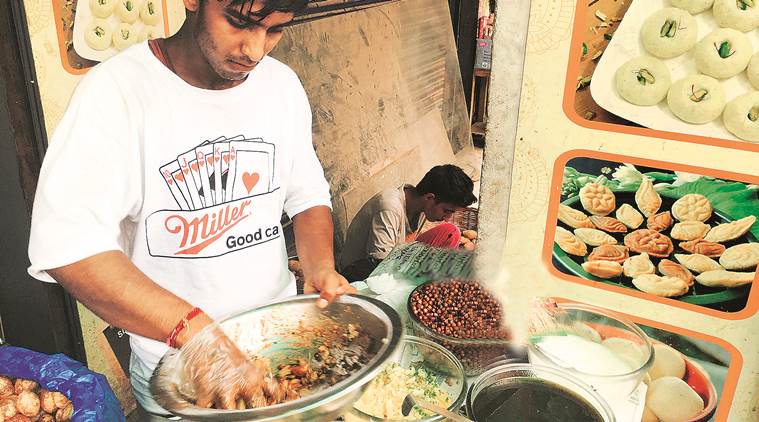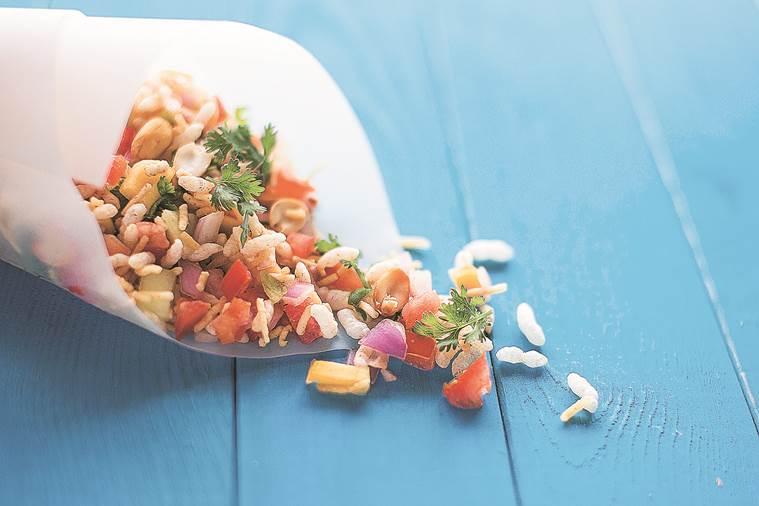 A vendor’s deft hands fixing a plate of churmur.
A vendor’s deft hands fixing a plate of churmur.
As the light afternoon showers give way to a muggy evening, the languorous markets of Chittaranjan Park morph into bustling bazaars. Renamed Chittaranjan Park, after the patriot Chittaranjan Das, in the ’80s, the neighbourhood was earlier known as the EPDP (East Pakistan Displaced Persons) Colony. For the better part of the day, the markets are home to grocers who balance Bengali kitchen essentials such as kasundi (mustard sauce), muri (puffed rice) and bori (lentil dumplings) on top of each other, like a house of cards, along with fish vendors.
But just before sunset, a host of other shopkeepers raise shutters and those functioning out of kachcha shops, set up stalls. One such stall is Raju Puchka Wala in Market I, who came to Delhi 20 years ago from Kishanganj in Bihar. As his stall’s name suggests, he sells the Bengali cousin of gol gappa, but with other street delicacies inspired from the offerings of street hawkers of Delhi and Mumbai. While sooji shells are an option at Raju’s stall, an atta cup makes for a better bet — thin, crisp and just the right size. The mash of potatoes and chickpeas is warmer than in other parts of the city and you can choose between “meetha and khatta pani”. A variant of Delhi’s much-loved aloo chaat, is found in Aloo Kabli that gains from the addition of tamarind water, onions and green chillies to the regular recipe. Yet another delight from this rickety stall, is churmur. The popular chaat of West Bengal is a cross between aloo kabli and a deconstructed puchka. He deftly jumbles up crushed atta shells, chickpeas, tamarind, potatoes, green chillies, coriander and black chickpeas in a bowl. It’s advised to ask him to go easy on the chillies; he tends to be heavy-handed.
 An all-time favourite jhaal muri. (Source: GettyImages)
An all-time favourite jhaal muri. (Source: GettyImages)
Close by is the popular Kolkata Hot Kathi Role. Unlike the adjoining food shops, this one starts operations at noon and serves up kathi rolls, chicken and mutton chops, fish fry and fish rolls, prawn cutlets, Mughlai parathas and shawarma. Sandeep Basak, who came to Delhi 10 years ago from Bihar’s Islampur, has been working at the shop since and says that they added Chinese dishes to their extensive menu eight years ago, because of “public demand”. But their best-rated item remains the kathi that comes with a generous dollop of mustard and raw mango kasundi, raw onion and a dusting of their “special powder”.
Bengali sweets are an ubiquitous sight. From cham cham, rosogulla, pantua, sandesh to dudh pulisita bhog, chandrapuli and lobongo lotika can be found stacked atop each other, peering out of glass showcases, luring passers-by. At the relatively new Akshay Tritiya, Bengal’s rosogulla acquires intriguing hues. The slightly yellow ball is mango flavoured while the parrot-green one takes on the tone of a raw mango. It isn’t sour but retains some semblance of the fruit’s zest.
Another apple of the Bengali chowhound’s eye is jhaal muri. Visas Biswas came to Delhi 15 years ago and worked at Annapurna Sweets before setting up his own stall in Market II, that now stands only a few feet from the famed sweet shop. He separates the delicacies he dishes out — jhaal muri, ghugni, ankur chaat and aloo kabli — in separate boxes and his hands move like clockwork. While he is hailed as CR Park’s “jhaalmuriwala”, his mutton ghugni is second to no other. A toothsome dish of chickpeas and minced mutton garnished with onions, tomatoes and sev.
In the back alley of Market II, is Maa Tara. Established in 1997, the restaurant makes for the perfect introduction to Bengali food. The Maa Tara Special Thali comprises rice, moong dal, luchi, dhokar dalna, fish fry, a tangy tomato chutney, aloo bhaja and pabda sorisa or kosha mangsho. These markets stand as a metaphor for CR Park: a little Bengal built by those who left their homes decades ago.